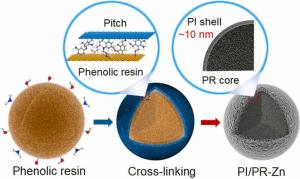Transforming sodium-ion battery technology: new strategy boosts hard carbon anodes
GA, UNITED STATES, September 28, 2025 /EINPresswire.com/ -- Sodium-ion batteries (SIBs) have long been hailed as a cost-effective alternative to lithium-ion batteries, but their performance has been hindered by inefficiencies in the anode material. A new study introduces an innovative approach to improving hard carbon (HC) anodes, which are vital for SIBs. By manipulating the interfacial chemistry of HC through an in situ coupling strategy, researchers have enhanced sodium ion transport and boosted both the storage capacity and rate capability of HC anodes. This breakthrough could be the key to unlocking the full potential of SIBs, making them a viable option for large-scale energy storage and electric vehicles.
Hard carbon (HC) has been identified as a promising material for sodium-ion batteries (SIBs) due to its low cost and structural stability. However, its performance has been limited by the slow transport of sodium ions, restricting its capacity and rate capability. Despite previous attempts to improve HC’s performance, the challenge has remained in optimizing its microstructure and electrochemical properties. To address these limitations, researchers have developed a groundbreaking strategy that enhances Na+ transport by regulating the interfacial chemistry of HC. This innovative approach not only improves the specific capacity of HC but also its long-term cycling stability, marking a significant advancement in sodium-ion battery technology.
A team of researchers from Nankai University and collaborating institutions has unveiled a new method to enhance the performance of SIBs. Published in eScience Energy, this study introduces a novel approach to modifying the interfacial chemistry of HC anodes, dramatically improving their sodium storage capacity and rate performance. By anchoring pitch onto phenolic resin spheres, the team has created a more efficient structure for Na+ transport. This new development promises to advance the commercialization of SIBs, offering a more affordable and sustainable solution for large-scale energy storage.
The research focuses on optimizing the performance of HC anodes for SIBs, addressing the long-standing issue of slow sodium ion transport. By employing an in situ coupling strategy, the team modified the interfacial chemistry of HC. They anchored pitch onto phenolic resin spheres, forming an interfacial structure that improves sodium ion mobility. This process suppressed the formation of open pores and reduced the graphitization of HC, enhancing both its specific capacity and cycling stability. The resulting PI/PR-Zn anode exhibited impressive electrochemical performance: a reversible capacity of 353 mAh g−1 at 50 mA g−1, a rate capability of 252.5 mAh g−1 at 1000 mA g−1, and 96% capacity retention after 1500 cycles. These results demonstrate the importance of interfacial chemistry in optimizing sodium storage materials. The study offers a new pathway for developing high-performance, long-lasting SIBs, potentially accelerating the adoption of SIBs in a range of applications.
"By manipulating the interfacial structure of HC, we've unlocked a new level of performance for SIBs," says Prof. Fujun Li from Nankai University. "This innovation not only improves sodium ion transport but also enhances the overall stability and capacity of HC anodes. This breakthrough provides a promising route for advancing SIBs, making them more viable for large-scale energy storage applications like electric vehicles and grid storage. Our findings mark a pivotal step toward achieving more sustainable and cost-effective energy storage solutions."
This study opens up new possibilities for the widespread adoption of SIBs, offering a more affordable and sustainable alternative to lithium-ion batteries. With enhanced sodium storage capacity and improved rate performance, the PI/PR-Zn anode could play a crucial role in a range of applications, including electric vehicles, renewable energy storage, and portable electronics. The ability to manufacture SIBs at a lower cost and with higher performance would be a game changer for industries looking to transition to more sustainable energy solutions. The study also paves the way for further innovations in the design of anode materials for next-generation batteries.
References
DOI
10.1016/j.esen.2025.100001
Original URL
https://doi.org/10.1016/j.esen.2025.100001
Funding informantion
This work was supported by the National Natural Science Foundation of China (W2412060 and 22325902), Natural Science Foundation of Tianjin City (24ZXZSSS00310 and 24JCZXJC00170), and NCC Fund (NCC2022FH03).
Lucy Wang
BioDesign Research
email us here
Legal Disclaimer:
EIN Presswire provides this news content "as is" without warranty of any kind. We do not accept any responsibility or liability for the accuracy, content, images, videos, licenses, completeness, legality, or reliability of the information contained in this article. If you have any complaints or copyright issues related to this article, kindly contact the author above.

